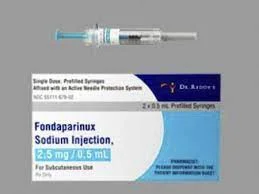Are you curious about fondaparinux? Wondering what makes it a unique anticoagulant that sets it apart from other options on the market? Look no further! In this blog post, we'll dive deep into the world of fondaparinux and explore its mechanism of action, benefits, risks, and who can benefit from its use. So buckle up and get ready to unravel the mysteries surrounding this remarkable medication. Let's embark on an exciting journey through the realm of anticoagulation therapy with fondaparinux!
What is fondaparinux?
Fondaparinux is a type of anticoagulant, also known as a blood thinner, that belongs to the class of medications called factor Xa inhibitors. Unlike other anticoagulants such as heparin or warfarin, fondaparinux specifically targets and inhibits the activity of factor Xa - an important enzyme involved in the clotting cascade.
This medication is derived from heparin but has been modified to have more selective effects on factor Xa without interfering with other coagulation factors. It is administered through subcutaneous injection once daily, making it convenient for patients who prefer not to take oral medications or require frequent monitoring.
Fondaparinux is primarily used for preventing and treating blood clots in conditions like deep vein thrombosis (DVT), pulmonary embolism (PE), and unstable angina. By inhibiting factor Xa, fondaparinux helps prevent the formation of new blood clots and reduces the risk of existing clots from progressing further.
It's important to note that fondaparinux should be used under medical supervision only. The dosage prescribed may vary depending on individual factors such as body weight, age, kidney function, and specific medical condition being treated.
While effective at preventing clot formation, like any medication, fondaparinux does carry some risks. These can include bleeding complications such as bruising easily or experiencing prolonged bleeding after injury or surgery. It's crucial to report any unusual bleeding episodes promptly to your healthcare provider while taking this medication.
Fondaparinux offers a targeted approach in combating dangerous blood clots by selectively inhibiting factor Xa activity. Its convenience in administration combined with its effectiveness makes it an attractive option for many individuals requiring anticoagulation therapy.

What are the different types of anticoagulants?
Anticoagulants, also known as blood thinners, are medications used to prevent the formation of blood clots. There are various types of anticoagulants available on the market, each with its own unique mechanism of action and characteristics.
One commonly prescribed type is warfarin, which works by inhibiting vitamin K-dependent clotting factors in the body. It requires regular monitoring and dose adjustments to maintain therapeutic levels.
Another type is heparin, which can be administered subcutaneously or intravenously. Heparins work by enhancing the activity of antithrombin III, a protein that helps regulate clotting.
Direct oral anticoagulants (DOACs), such as dabigatran and rivaroxaban, have gained popularity in recent years. These newer agents directly target specific clotting factors in the blood, offering more convenience compared to traditional options.
Fondaparinux belongs to a class called synthetic pentasaccharide inhibitors. It selectively blocks factor Xa in the coagulation cascade without affecting other clotting factors.
It's important to note that different individuals may respond differently to each type of anticoagulant due to variations in their underlying conditions and medical history. Hence, it's crucial for healthcare professionals to carefully evaluate each patient before initiating any treatment regimen involving these medications
How does fondaparinux work?
Fondaparinux, a type of anticoagulant, works by inhibiting a key factor in the blood clotting process. Specifically, it targets and binds to antithrombin III, a natural protein in the body that regulates blood clot formation.
When fondaparinux binds to antithrombin III, it enhances its ability to block the activity of certain clotting factors - namely thrombin and factor Xa. By doing so, fondaparinux helps prevent the formation of new blood clots and also reduces the risk of an existing clot growing larger.
Unlike other anticoagulants like warfarin or heparin, fondaparinux specifically targets factor Xa and does not interact with other proteins involved in coagulation. This targeted mechanism makes fondaparinux effective for preventing deep vein thrombosis (DVT) after surgery or for treating certain types of pulmonary embolism (PE).
It is important to note that fondaparinux is administered as an injection under the skin rather than orally. This allows for a more direct delivery into the bloodstream without being metabolized by the digestive system.
Understanding how fondaparinux works can provide insight into its effectiveness as an anticoagulant option for those at risk of developing dangerous blood clots.
What are the benefits and risks of fondaparinux?
Fondaparinux, as an anticoagulant, offers several benefits and comes with certain risks. Let's take a closer look at both sides.
Benefits:
- Effective prevention of blood clots: Fondaparinux is highly effective in preventing the formation of blood clots, specifically deep vein thrombosis (DVT) and pulmonary embolism (PE). This can be particularly beneficial for individuals undergoing hip or knee replacement surgeries or those with a history of clotting disorders.
- Convenient administration: Unlike some other anticoagulants that require daily injections, fondaparinux is usually administered once daily subcutaneously. This makes it more convenient for patients to manage their medication regimen.
- Lower risk of bleeding complications: Compared to older generation anticoagulants like heparin, fondaparinux has shown a lower risk of major bleeding events. This can be reassuring for individuals who are at high risk for such complications.
Risks:
- Increased risk of bleeding: While the risk is generally low, all anticoagulants carry the potential side effect of increased bleeding. It's important to closely monitor patients on fondaparinux therapy and promptly address any signs or symptoms indicating excessive bleeding.
- Allergic reactions: Some individuals may experience allergic reactions to fondaparinux, resulting in skin rashes, itching, or difficulty breathing. Any unusual reaction should be reported to healthcare professionals immediately.
- Limited reversal agent availability: In emergency situations where immediate reversal of the anticoagulant effect is required, there are limited options available for reversing fondaparinux compared to other agents like warfarin or heparin.
It's crucial for healthcare providers to carefully weigh these benefits against potential risks before prescribing fondaparinux to ensure optimal patient outcomes. Always consult with your healthcare professional regarding any concerns about this medication.

Who should take fondaparinux?
Who should take fondaparinux? Fondaparinux is a medication that belongs to a class of anticoagulants called factor Xa inhibitors. It is primarily used for preventing blood clots in certain medical conditions. However, not everyone is suitable for taking fondaparinux.
Fondaparinux may be prescribed to individuals who have had orthopedic surgery, such as hip or knee replacement, to prevent deep vein thrombosis (DVT) and pulmonary embolism (PE). It can also be used in the treatment of acute coronary syndrome (ACS), which includes conditions like unstable angina and heart attack.
Patients with renal impairment or severe liver disease may need dosage adjustments or close monitoring while taking fondaparinux. Additionally, those with an increased risk of bleeding or allergic reactions should exercise caution when considering this medication.
It's crucial to consult with your healthcare provider before starting fondaparinux therapy. They will assess your specific medical condition, overall health status, and any potential drug interactions before determining if it's appropriate for you.
Remember that this information does not replace personalized medical advice from a qualified professional. Always follow their guidance and never self-medicate without proper consultation.
How to use fondaparinux
Using fondaparinux correctly is essential to ensure its effectiveness and minimize the risk of complications. Here are some important guidelines to follow when using this anticoagulant.
1. Administration: Fondaparinux is usually injected subcutaneously (under the skin) once a day. It's crucial to use the proper injection technique recommended by your healthcare provider or pharmacist.
2. Timing: Take fondaparinux at the same time each day to maintain consistent levels in your body. Setting a reminder can be helpful, especially if you have a busy schedule.
3. Dosage: The dose of fondaparinux prescribed will depend on various factors such as your weight, medical condition, and other medications you may be taking. Always follow your doctor's instructions regarding dosage adjustments or any changes in treatment duration.
4. Storage: Store fondaparinux according to the instructions provided with the medication packaging. Keep it at room temperature away from direct sunlight, heat, or moisture.
5.Interactions: Inform your healthcare provider about all prescription drugs, over-the-counter medications, vitamins, and herbal supplements you are currently taking before starting fondaparinux therapy.
Remember that these guidelines serve as general information only and should not replace professional medical advice tailored specifically for you.

Conclusion
Fondaparinux is a type of anticoagulant that belongs to the class of drugs known as Factor Xa inhibitors. It works by blocking the activity of a specific clotting factor in the blood, reducing the risk of blood clots forming and preventing existing clots from growing larger.
Like all medications, fondaparinux has its benefits and risks. The main benefit is its ability to effectively prevent or treat conditions associated with abnormal blood clotting, such as deep vein thrombosis (DVT) and pulmonary embolism (PE). However, it also carries some potential risks, including bleeding complications. Therefore, it is essential for healthcare professionals to carefully assess each individual's medical history and consider other factors before prescribing fondaparinux.
Fondaparinux should only be taken under medical supervision and according to the prescribed dosage instructions. It is typically administered through subcutaneous injection once daily. Patients need to follow these instructions closely to ensure they receive the maximum benefit from this medication while minimizing any potential side effects.
It's important to note that fondaparinux may not be suitable for everyone. Individuals who have an increased risk of bleeding or those with severe kidney problems should avoid taking this medication without consulting their healthcare provider first.
Fondaparinux serves as an effective anticoagulant used in certain clinical situations where preventing or treating blood clots is crucial. However, it should always be used under professional guidance due to both its benefits and potential risks. If you believe you could benefit from using fondaparinux or have concerns about your current anticoagulation treatment plan, welcome to consult Shanghai Minbiotch Co., Ltd.,a company specializing in the RD and production of advanced pharmaceutical intermediates and biological APIs. for personalized advice tailored specifically to your needs.Sales@minbiotech.com








